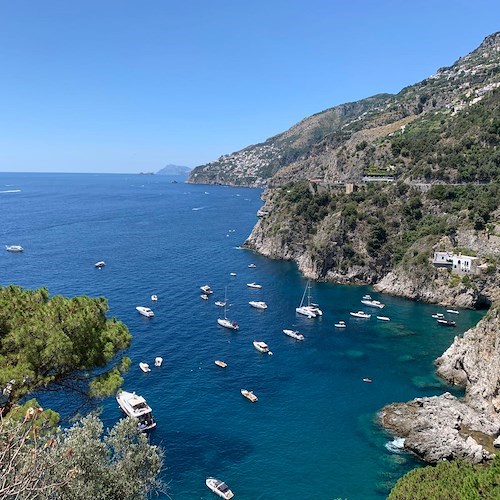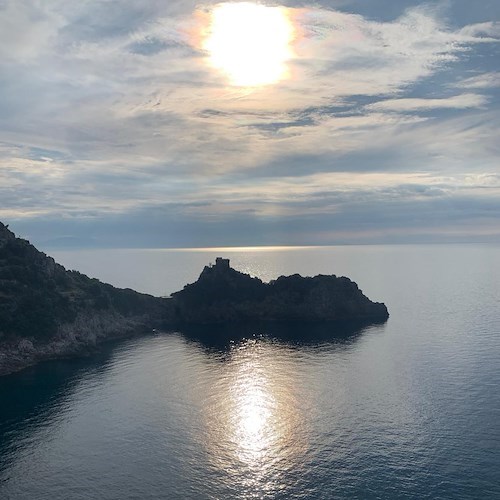You are here: Picturesque townsConca dei Marini, a timeless treasure on the Amalfi Coast
Written by (Massimiliano D'Uva), Saturday, November 23, 2024 3:14:43 PM

A picturesque and charming fishing village, the history of Conca dei Marini, like all the other towns of the Amalfi Coast, is closely related to the events of the ancient Maritime Republic of Amalfi: the chronicles of the time, in fact, narrate that the inhabitants of Conca dei Marini were skilled sailors and experienced traders, which owned 27 large galleons. Its typical houses in Mediterranean style feature vaulted ceilings and whitewashed walls, balconies with beautiful flowers and a spectacular view over the sea. The terraces cultivated with lemons and tomatoes of the piennolo, the tranquility and the fresh sea breeze made Conca Marini the ideal "buen retiro" for lovers of discretion and quietness. It was, in fact, a preferred resort of important writers, artists and chiefs of state, such as: Princess Margaret of England, Gianni Agnelli, Jacqueline Kennedy, the Queen of Holland, Carlo Ponti and Moet & Chandon.
Among the most valuable monuments of art and history, not to miss:
-the Monastery of St. Rosa from Lima, with its adjacent church of Santa Maria di Grado. A former Dominican monastery, built in the VXII century on a rocky promontory overlooking the entire Gulf of Salerno, it features an austere exterior, whilst the interior is richly decorated. Here, according to tradition, the exquisite sfogliatella Santa Rosa was realized for the first time, a typical puff pastry filled with cream and pieces of fruit. The church preserves part of the skull of St. Barnabas the Apostle, one of the most important relics of the Amalfi Coast.
-the Church of San Pancrazio, surrounded by a beautiful olive grove (where the poet Alfonso Gatto, used to wander around in search of inspiration), enjoys an incomparable view on the Faraglioni of Capri and Positano. It was mentioned for the first time in an official document of 1370 of the Archbishop of Amalfi, Monsignor Marino, and was harshly sacked in 1543 and remained closed for a long time.
-the Church of San Michele Arcangelo, immersed in an evergreen Mediterranean vegetation, was mentioned for the first time in a document dated 1208;
-the Church of St. John the Baptist and St. Anthony from Padua, of uncertain origins, is situated on a rocky cliff. The discovery of some urns leads the historians to hypothesize that the building stands on the ruins of an ancient pagan temple;
-the Chapel of Our Lady of the Snow, perched on the rocks near the beach of Marina di Conca, is the protector of the sailors. The local traditions narrate that the high-relief depicting the Madonna was found by sailors of Conca dei Marini on the beach of Constantinople after the sack by the Ottomans;
-the Emerald Grotto, a karst cave discovered in 1932, which takes its name from the emerald colors in the water, produced by the sunlight filtered through a submarine entrance;
-the fortified Tower of Capo di Conca, also known as the Saracen Tower or White Tower, an ancient XVI century watchtower located on a picturesque promontory over the sea and surrounded by a thick Mediterranean vegetation. It was part of the defensive tower system built along the coast of the entire Amalfi Coast, to defend the population from pirate raids. However, after the defeat of the Turks at Lepanto, the tower lost its original purpose and was used until 1949 as a cemetery (for some it has been compared to the "towers of silence" in India).
-Marina di Conca, a charming small creek surrounded by a group of houses facing the sea. It is not only a small natural harbor where the fishing boats dock, but also the centre, where in the past, the active life of the town was concentrated.
 Conca dei Marini, Amalfi Coast
© Massimiliano D'Uva
Conca dei Marini, Amalfi Coast
© Massimiliano D'Uva
 Capo di Conca
© Massimiliano D'Uva
Capo di Conca
© Massimiliano D'Uva
 Monastero Santa Rosa, Amalfi Coast
© Massimiliano D'Uva
Monastero Santa Rosa, Amalfi Coast
© Massimiliano D'Uva
 Conca dei Marini, Amalfi Coast, terra di limoni
© Massimiliano D'Uva
Conca dei Marini, Amalfi Coast, terra di limoni
© Massimiliano D'Uva
 Conca dei Marini, Amalfi Coast
© Massimiliano D'Uva
Conca dei Marini, Amalfi Coast
© Massimiliano D'Uva
 Capo di Conca
© Massimiliano D'Uva
Capo di Conca
© Massimiliano D'Uva
 Positano Notizie Summer 2020
© Massimiliano D'Uva
Positano Notizie Summer 2020
© Massimiliano D'Uva
 Conca dei Marini
© Massimiliano D'Uva
Conca dei Marini
© Massimiliano D'Uva
rank: 106911101
"Words can hardly describe the sunset as seen from this place, where the great planet offers a surprising and unique effect of light; appearing like a glowing sphere descending slowly toward the horizon, into a vast sea that seems to be made of both fire and light, almost saluting with its final rays...
Perched on a rocky outcrop at 365 meters above sea level, Ravello sits in the heart of the Amalfi Coast, overlooking the entire Gulf of Salerno. It is one of the most beloved destinations along the "Divine Coast," thanks to its irresistible charm and worldwide fame—a perfect blend of art and music that...
The beauty of the Amalfi Coast never ceases to amaze, but there are moments when nature seems to outdo itself. This is the case with this stunning aerial shot, taken at dawn by Vietri-born photographer and entrepreneur Carlo De Felice, capturing the magic of the first light of day as it gently touches...
Land between the mountains ("intra montes" in Latin), Tramonti is a wonderful town on the Amalfi Coast, set at the foot of the Lattari Mountains and surrounded by a suggestive bucolic landscape consisting of about 145 acres of woods, terraces cultivated with lemon trees, olive trees, and vineyards. The...